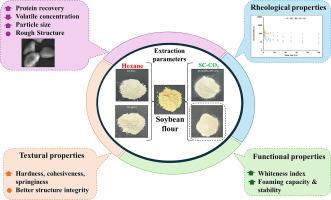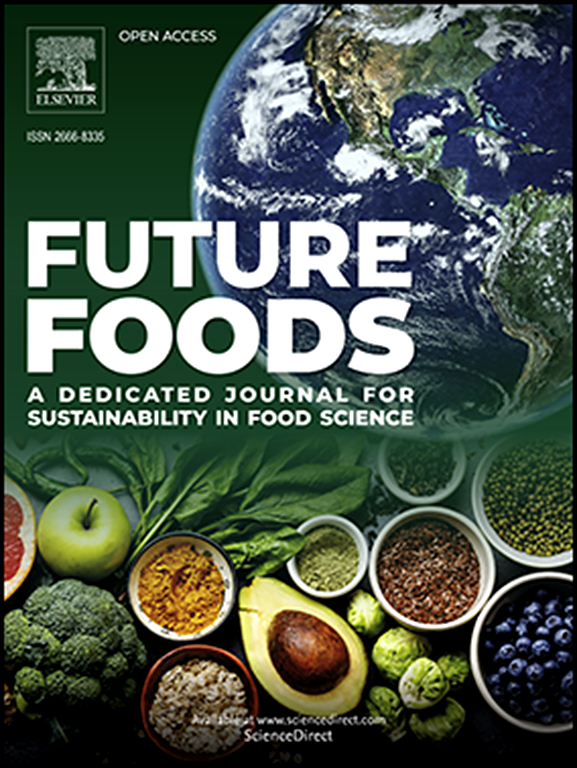The impact of supercritical carbon dioxide processing on the aroma and physicochemical properties of soybean flour
IF 7.2
Q1 FOOD SCIENCE & TECHNOLOGY
引用次数: 0
Abstract
Soybeans are rich in protein but have limited food applications due to their undesirable volatile compounds, negatively affecting their flavor and consumer acceptance. This study aimed to extract lipids and volatile compounds from soybean flour using supercritical carbon dioxide (SC![]() CO2) and investigate the impact of extraction conditions on the properties of soybean flour, including particle size distribution, composition, color, and rheological and textural qualities. Similar lipid extraction yields (∼20 %) were obtained with SC
CO2) and investigate the impact of extraction conditions on the properties of soybean flour, including particle size distribution, composition, color, and rheological and textural qualities. Similar lipid extraction yields (∼20 %) were obtained with SC![]() CO2 and conventional hexane extractions. The volatile compound concentration of the soybean flour was reduced after SC
CO2 and conventional hexane extractions. The volatile compound concentration of the soybean flour was reduced after SC![]() CO2 extraction (0.63–1.00 µg/g) as compared to hexane extraction (1.44–1.68 µg/g). The results showed that SC
CO2 extraction (0.63–1.00 µg/g) as compared to hexane extraction (1.44–1.68 µg/g). The results showed that SC![]() CO2-treated soybean flour showed smaller particle sizes (<250 µm, ∼70 %), improved protein purity upon protein extraction, and brighter color as compared to hexane-extracted flour. Additionally, in comparison to untreated soybean flour, SEM images revealed a more disrupted and rough structure in defatted soybean flour. Overall, the presented SC
CO2-treated soybean flour showed smaller particle sizes (<250 µm, ∼70 %), improved protein purity upon protein extraction, and brighter color as compared to hexane-extracted flour. Additionally, in comparison to untreated soybean flour, SEM images revealed a more disrupted and rough structure in defatted soybean flour. Overall, the presented SC![]() CO2 approach can improve the aroma of soybean flour while achieving similar lipid extraction yields with conventional hexane extraction, all without the use of toxic organic solvents.
CO2 approach can improve the aroma of soybean flour while achieving similar lipid extraction yields with conventional hexane extraction, all without the use of toxic organic solvents.

超临界二氧化碳加工对大豆粉香味和理化特性的影响
大豆含有丰富的蛋白质,但由于其不受欢迎的挥发性化合物而限制了其在食品中的应用,对其风味和消费者接受度造成了负面影响。本研究旨在使用超临界二氧化碳(SCCO2)从大豆粉中提取脂质和挥发性化合物,并研究提取条件对大豆粉特性的影响,包括粒度分布、成分、颜色、流变性和质地。SCCO2 和传统正己烷萃取法获得了相似的脂质萃取率(20%)。与正己烷萃取(1.44-1.68 µg/g)相比,SCCO2 萃取后大豆粉中的挥发性化合物浓度降低了(0.63-1.00 µg/g)。结果表明,与正己烷提取的面粉相比,SCCO2 处理的大豆面粉粒径更小(250 微米,70%),蛋白质提取后的蛋白质纯度更高,颜色更鲜艳。此外,与未经处理的大豆面粉相比,扫描电镜图像显示脱脂大豆面粉的结构更加混乱和粗糙。总之,所介绍的 SCCO2 方法可以改善大豆面粉的香味,同时达到与传统正己烷提取相似的脂质提取率,而且无需使用有毒的有机溶剂。
本文章由计算机程序翻译,如有差异,请以英文原文为准。
求助全文
约1分钟内获得全文
求助全文
来源期刊

Future Foods
Agricultural and Biological Sciences-Food Science
CiteScore
8.60
自引率
0.00%
发文量
97
审稿时长
15 weeks
期刊介绍:
Future Foods is a specialized journal that is dedicated to tackling the challenges posed by climate change and the need for sustainability in the realm of food production. The journal recognizes the imperative to transform current food manufacturing and consumption practices to meet the dietary needs of a burgeoning global population while simultaneously curbing environmental degradation.
The mission of Future Foods is to disseminate research that aligns with the goal of fostering the development of innovative technologies and alternative food sources to establish more sustainable food systems. The journal is committed to publishing high-quality, peer-reviewed articles that contribute to the advancement of sustainable food practices.
Abstracting and indexing:
Scopus
Directory of Open Access Journals (DOAJ)
Emerging Sources Citation Index (ESCI)
SCImago Journal Rank (SJR)
SNIP
 求助内容:
求助内容: 应助结果提醒方式:
应助结果提醒方式:


